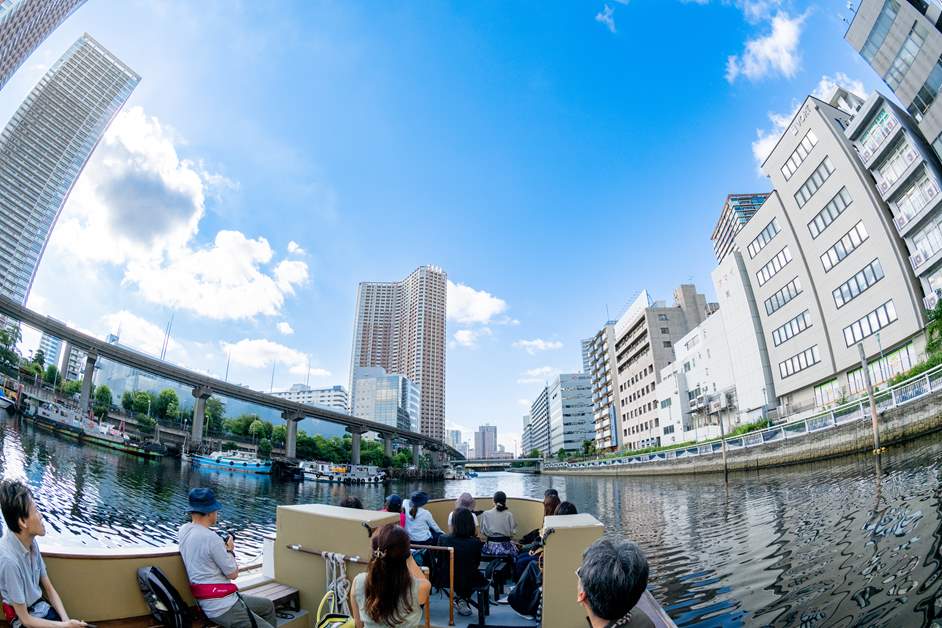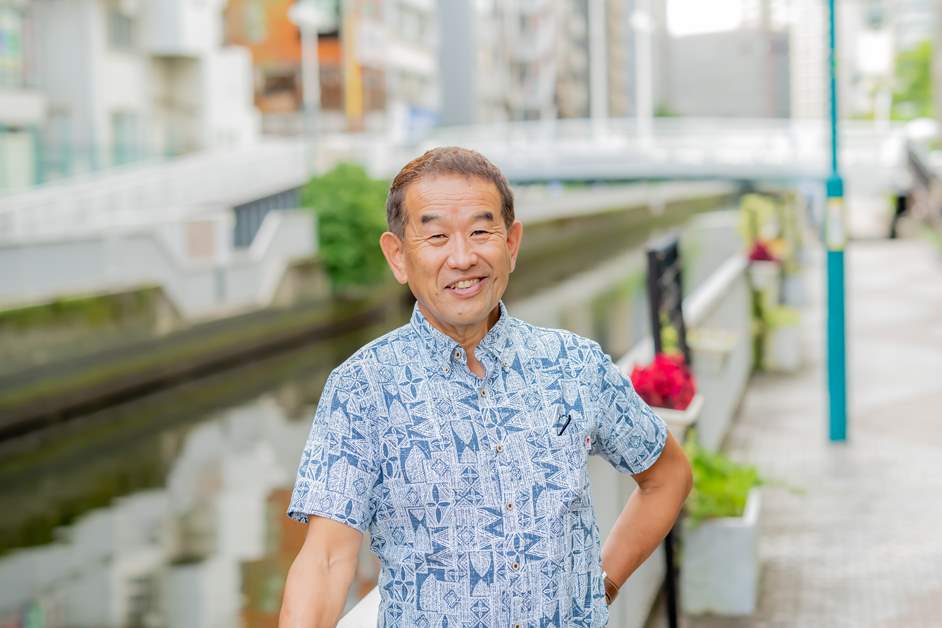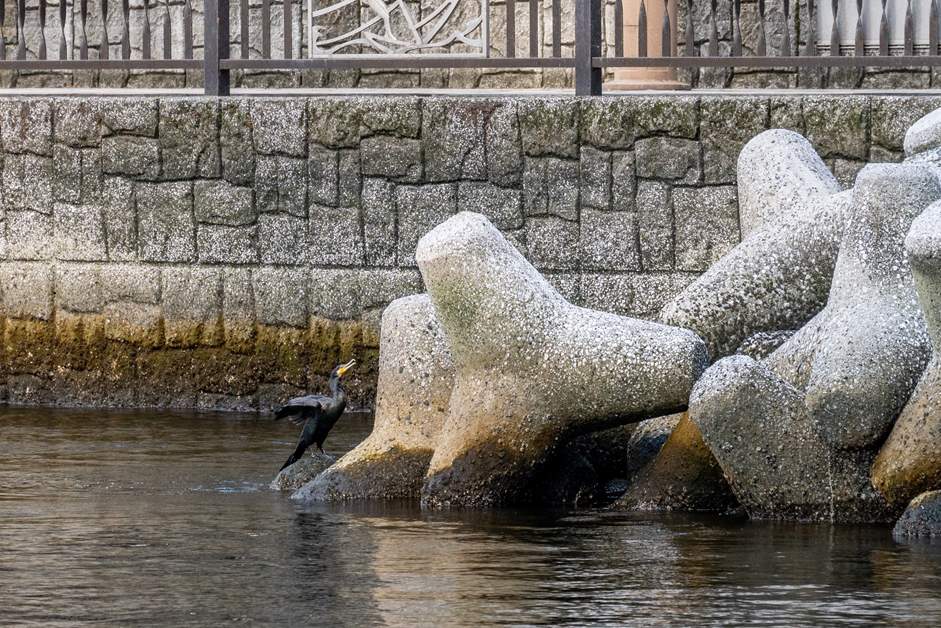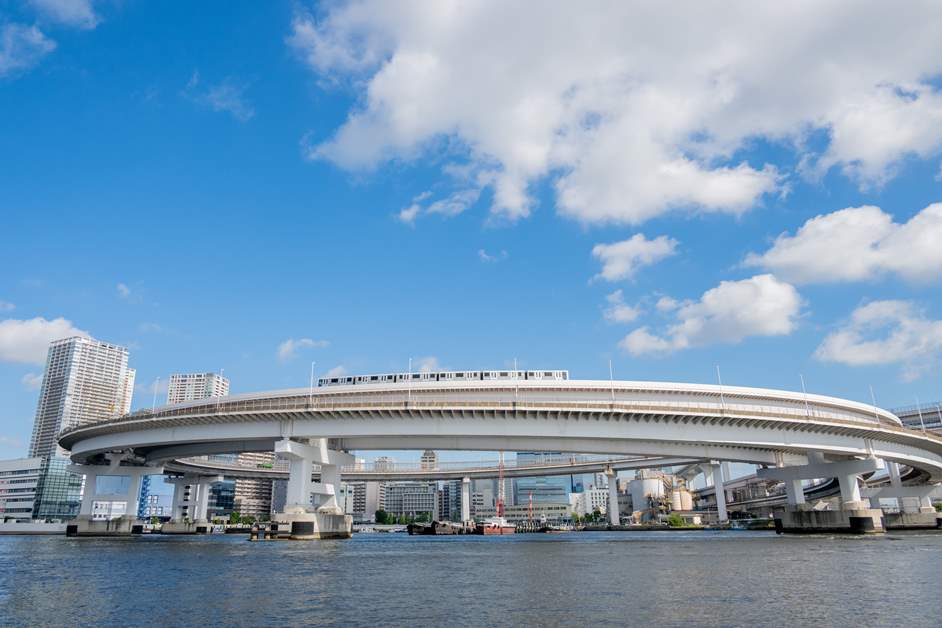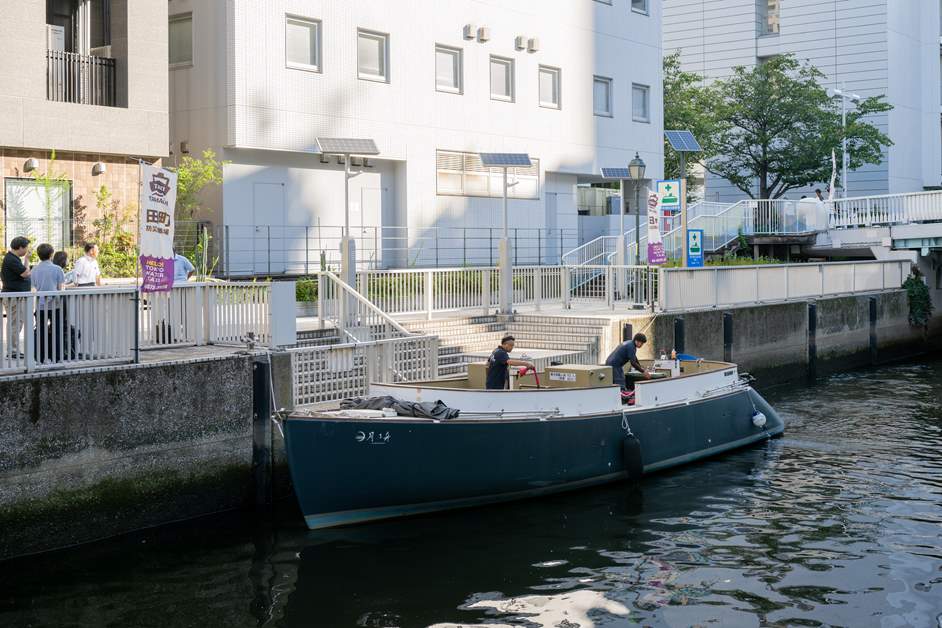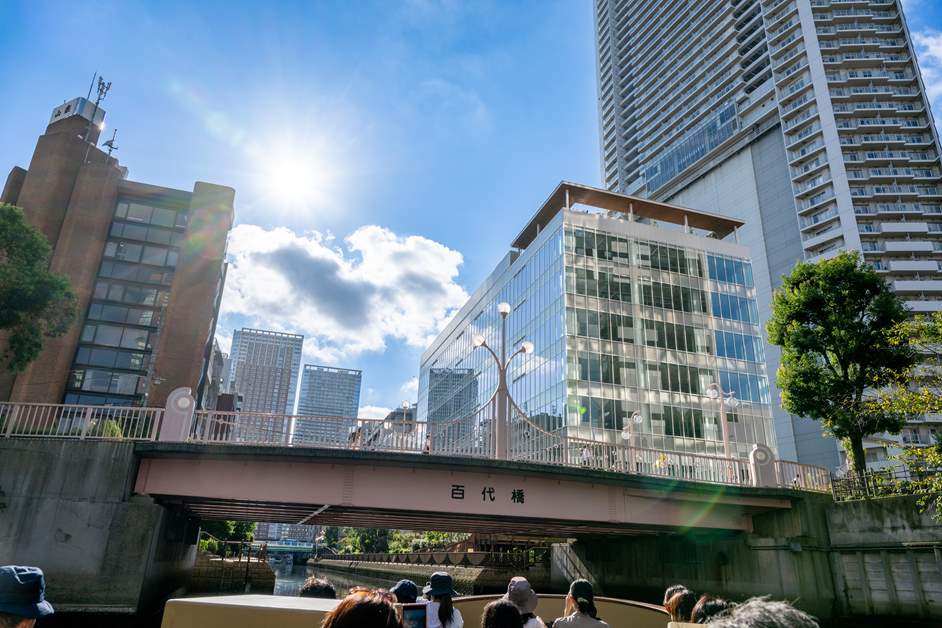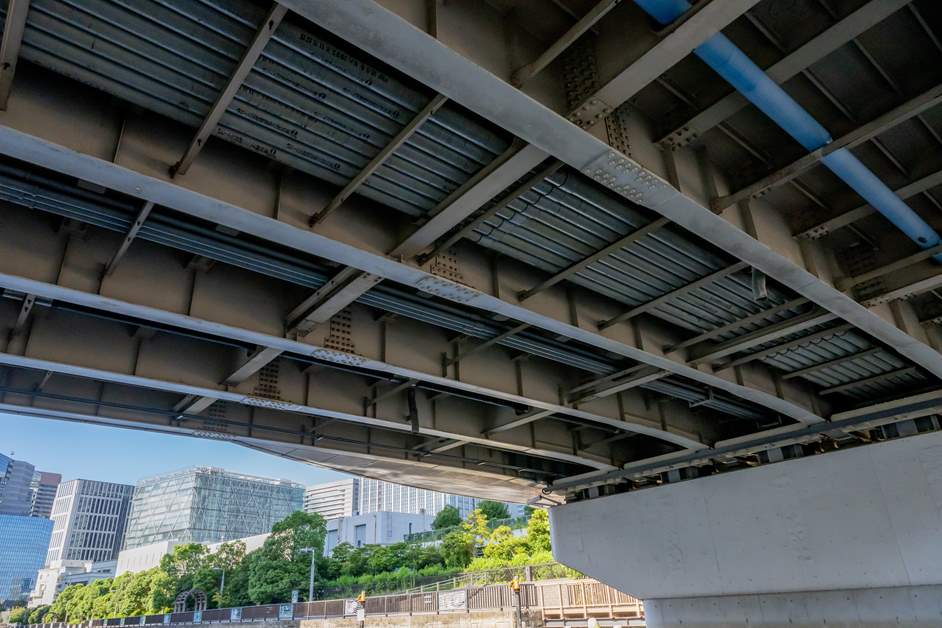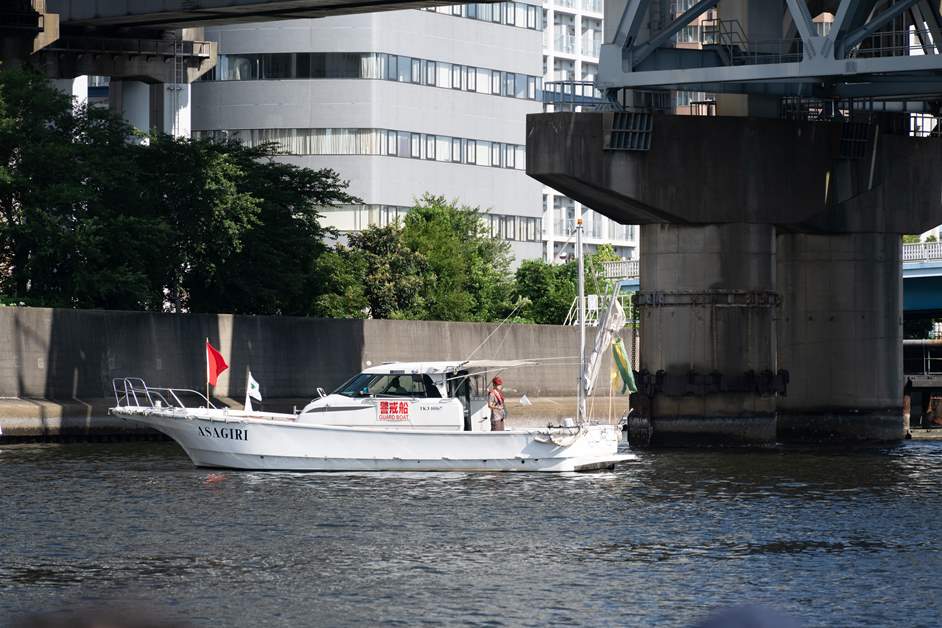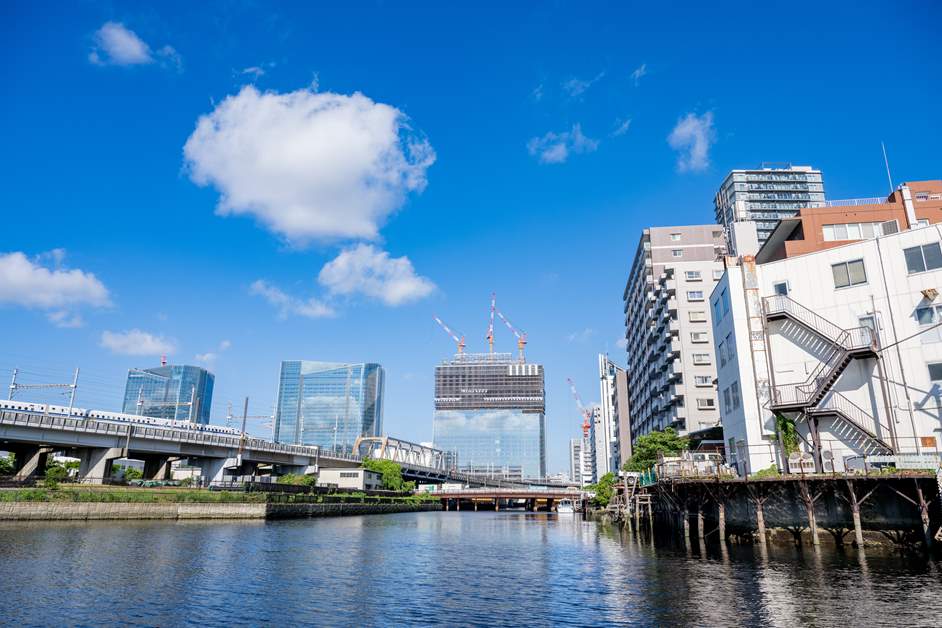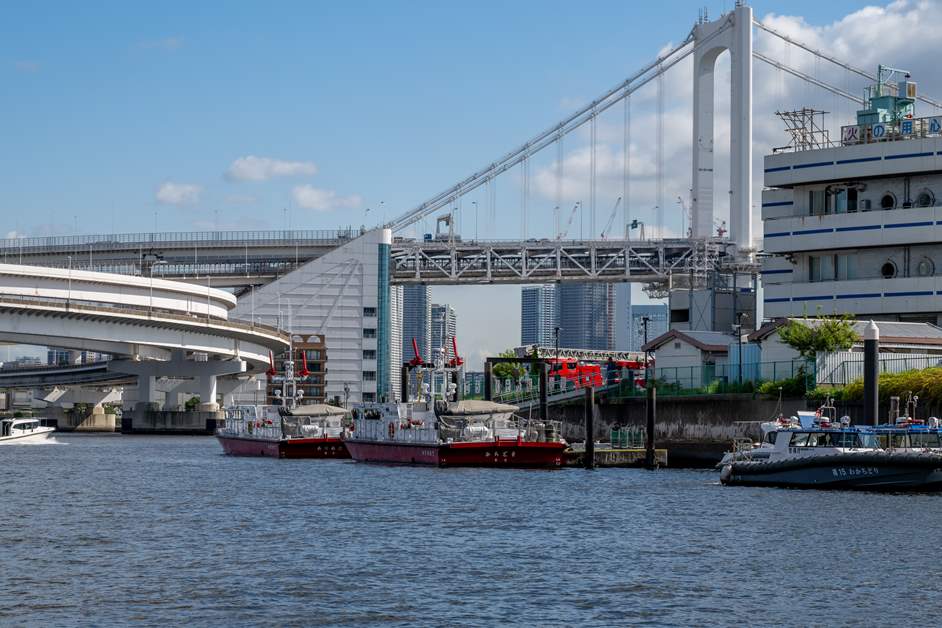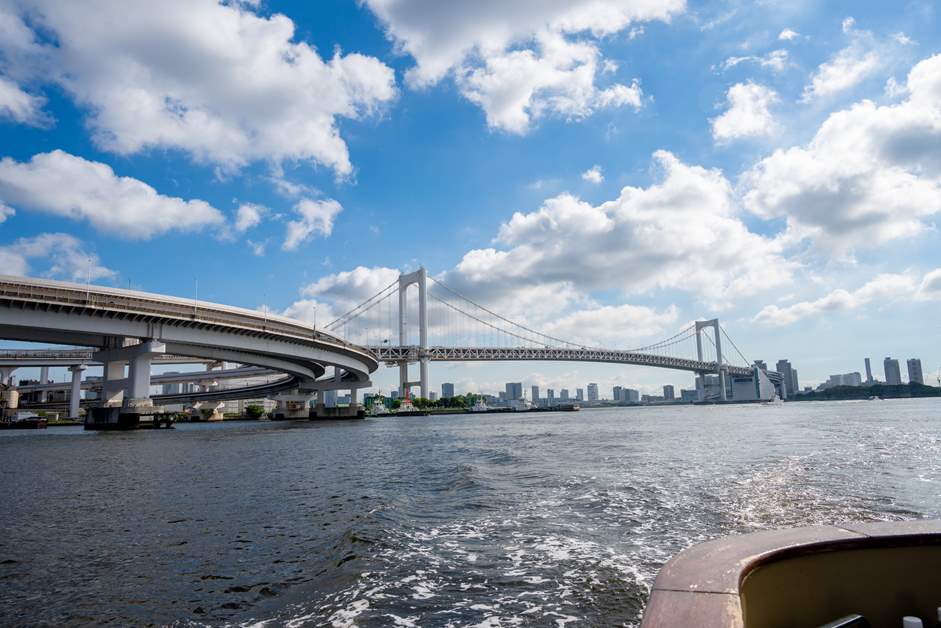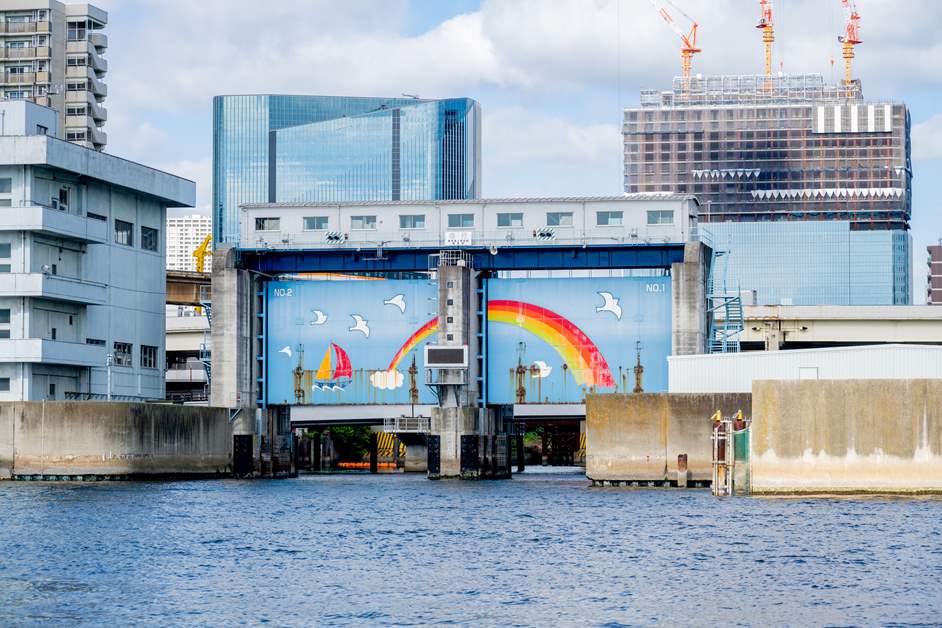Getting to Know the Minato City Waterfront! Early-Riser Activities with an 8:00 a.m. Morning Cruisees with a morning cruise at 8 a.m.
Minato City is engaged in a variety of initiatives that seek to leverage the diverse tourism opportunities presented by its waterfront area, including the Shibaura Canal and Tokyo Bay. As part of these initiatives, 8:00 a.m. morning cruises along the Shibaura Canal and around other areas of the waterfront were held on September 13 and September 25, 2024. For this article, we spoke with Mr Takumi Hirano, chairman of the Tokyo Minato City Travel & Tourism Association - Waterfront Division, and representative director of ZEAL Co.,LTD., about a range of topics, including the appeal of cruises and the Minato City waterfront and the on-going changes to the local environment. We will also give our report on the maiden cruise in the initiative, which took place on a morning blessed with blue skies.
Purpose of the Cruise Project and Description of the Activities of the Waterfront Division
――These morning cruises are the first such initiative in Minato City. Could you please start by telling us what your goals were with the project?
“The main goal of the project was to bring an energy to the Minato City waterfront and to create a more lively atmosphere in the area. The Shibaura Canal runs roughly two to three meters below street level. With these cruises, we aimed to show people the Shibaura streetscape in which they live from a slightly different and lower down perspective to what they normally experience it. Through this new perspective, we hoped to foster an understanding of the value of the waterfront area. We used roofless boats for the cruises, which meant that there were times where all the different elements in the environment, including the buildings, sky, and clouds, all came together to form a single painting-like composition. I would really like to convey just how beautiful the view from the canal is. Also, the reason that we ran the cruises so early in the morning is because it is such a pleasant time of day. The temperatures are not so high, even during the summer months. Also, it is a time where you can better get a feel for the natural environment, including being able to hear the sound of birdsong and the morning breeze.”
“The main goal of the project was to bring an energy to the Minato City waterfront and to create a more lively atmosphere in the area. The Shibaura Canal runs roughly two to three meters below street level. With these cruises, we aimed to show people the Shibaura streetscape in which they live from a slightly different and lower down perspective to what they normally experience it. Through this new perspective, we hoped to foster an understanding of the value of the waterfront area. We used roofless boats for the cruises, which meant that there were times where all the different elements in the environment, including the buildings, sky, and clouds, all came together to form a single painting-like composition. I would really like to convey just how beautiful the view from the canal is. Also, the reason that we ran the cruises so early in the morning is because it is such a pleasant time of day. The temperatures are not so high, even during the summer months. Also, it is a time where you can better get a feel for the natural environment, including being able to hear the sound of birdsong and the morning breeze.”
――One of the unique characteristics of the Shibaura Canal does seem to be its unique ecosystem, including the birds and fish.
“This is something referred to as ‘urban nature.’ You will find a wide variety of wildlife in and around the Shibaura Canal. Birds, fish, and even turtles make it their home. However, the types of animals living there have changed a lot relative to the past. One of the main reasons for this is the vast improvement in the quality of the water that feeds into Tokyo Bay from the local rivers, which itself is because of improvements in the processing capabilities of the sewage system. As the water has become cleaner, it has become more hospitable to small fish such as flathead mullet and gobies, and even shellfish such as crab and shrimp. This, in turn, has led to an increase in the numbers of birds that feed on them. For example, it used to be rare to see a heron on the canal. But now, we see four different types of them. We’ve also started to see ducks and coots too, who come to feed on the green algae that grow along the banks of the canal. When I first started my business in Shibaura 30 years ago, you rarely saw these types of birds. Also, in November you start to see the waterfowl migrating over from Siberia. They really bring the area to life. I would really recommend the waterfront area in the period from fall to winter.”
“This is something referred to as ‘urban nature.’ You will find a wide variety of wildlife in and around the Shibaura Canal. Birds, fish, and even turtles make it their home. However, the types of animals living there have changed a lot relative to the past. One of the main reasons for this is the vast improvement in the quality of the water that feeds into Tokyo Bay from the local rivers, which itself is because of improvements in the processing capabilities of the sewage system. As the water has become cleaner, it has become more hospitable to small fish such as flathead mullet and gobies, and even shellfish such as crab and shrimp. This, in turn, has led to an increase in the numbers of birds that feed on them. For example, it used to be rare to see a heron on the canal. But now, we see four different types of them. We’ve also started to see ducks and coots too, who come to feed on the green algae that grow along the banks of the canal. When I first started my business in Shibaura 30 years ago, you rarely saw these types of birds. Also, in November you start to see the waterfowl migrating over from Siberia. They really bring the area to life. I would really recommend the waterfront area in the period from fall to winter.”
――Compared to the past, it really seems like there has been a large increase in the numbers of animals.
“That's right. And, while the improved quality of the water has been a big part in that, Minato City has also been taking other measures to help increase wildlife along the canal, including building man-made shallows and floating islands. I’m sure that these constructions have also played some part. I hope that those who join the cruises will notice the efforts that have been taken.”
“That's right. And, while the improved quality of the water has been a big part in that, Minato City has also been taking other measures to help increase wildlife along the canal, including building man-made shallows and floating islands. I’m sure that these constructions have also played some part. I hope that those who join the cruises will notice the efforts that have been taken.”
――What are some other things that you might see along the Shibaura Canal aside from the wildlife?
“There are lots of things, but I think that being able to see the Tokyo Monorail run alongside the canal is one of the most unique standout attractions. It’s not often you get to see the monorail from directly below, after all. And, the people riding the monorail also get to gaze down on the canal from above, so there are two perspectives from which you can enjoy the waterfront."
“There are lots of things, but I think that being able to see the Tokyo Monorail run alongside the canal is one of the most unique standout attractions. It’s not often you get to see the monorail from directly below, after all. And, the people riding the monorail also get to gaze down on the canal from above, so there are two perspectives from which you can enjoy the waterfront."
――Another attraction is the fact that the cruise ship exits out into Tokyo Bay. I imagine that the Rainbow Bridge in particular is a big draw?
“Well, the Rainbow Bridge is certainly a popular spot, but I think that the Shibaura Loop Bridge, with its elaborate 360-degree curved road, is also a big highlight. There are also moorings for working vessels, and patrol boats that guide other boats in the bay during construction works. These are sights that you don’t normally get to see and are always crowd-pleasers for those on the cruise.”"
“Well, the Rainbow Bridge is certainly a popular spot, but I think that the Shibaura Loop Bridge, with its elaborate 360-degree curved road, is also a big highlight. There are also moorings for working vessels, and patrol boats that guide other boats in the bay during construction works. These are sights that you don’t normally get to see and are always crowd-pleasers for those on the cruise.”"
――The cruise project seems like one of the leading examples of plans to revitalize the waterfront area of Minato City, but what are some of the other initiatives being considered by the Waterfront Division?
“The Tokyo Minato City Travel & Tourism Association is made up of around 30 core members, whose role it is to promote projects relating to the waterfront area of Minato City. We are currently considering ways that we can attract people to the promenade on the waterfront. For example, while the waterfront does have a park and benches, there are no dedicated spots for enjoying some tea as you look out over the river or somewhere where you can have a beer. I think it’s vital that we create a space that not only appeals to residents of Shibaura, but that is also welcoming to tourists, from both Japan and overseas. I’m sure people would be overwhelmingly receptive to the idea of having somewhere where they could stop, rest, and have a bite to eat during their walks along the waterfront promenade. I think it would be great if Minato City could ultimately become somewhere like Venice in Italy where you can travel between the main spots by boat.”
“The Tokyo Minato City Travel & Tourism Association is made up of around 30 core members, whose role it is to promote projects relating to the waterfront area of Minato City. We are currently considering ways that we can attract people to the promenade on the waterfront. For example, while the waterfront does have a park and benches, there are no dedicated spots for enjoying some tea as you look out over the river or somewhere where you can have a beer. I think it’s vital that we create a space that not only appeals to residents of Shibaura, but that is also welcoming to tourists, from both Japan and overseas. I’m sure people would be overwhelmingly receptive to the idea of having somewhere where they could stop, rest, and have a bite to eat during their walks along the waterfront promenade. I think it would be great if Minato City could ultimately become somewhere like Venice in Italy where you can travel between the main spots by boat.”
――So, the aim is for boats to become one of the modes of transport for the area?
“Minato City has a natural river called the Furukawa River, whose source lies in a spring in the Shinjuku Gyoen National Garden in Shinjuku. It flows through the Shibuya River in Shibuya, before it enters midway along its course into Minato City, where it becomes the Furukawa River. The mouth of the Furukawa River lies between Hinode Pier and Takeshiba Pier, and you can actually travel up as far as the Ninohashi Bridge in Azabujuban by boat. The Ninohashi Bridge is located right next to Azabujuban Station. I bet most people have no idea that you can travel there by boat. There are many challenges and it may take some time to realize, but I think that if we were able to make it possible to travel between the Azabujuban and Shibaura districts by boat, then it would become a real talking point and a great tourism resource.”
“Minato City has a natural river called the Furukawa River, whose source lies in a spring in the Shinjuku Gyoen National Garden in Shinjuku. It flows through the Shibuya River in Shibuya, before it enters midway along its course into Minato City, where it becomes the Furukawa River. The mouth of the Furukawa River lies between Hinode Pier and Takeshiba Pier, and you can actually travel up as far as the Ninohashi Bridge in Azabujuban by boat. The Ninohashi Bridge is located right next to Azabujuban Station. I bet most people have no idea that you can travel there by boat. There are many challenges and it may take some time to realize, but I think that if we were able to make it possible to travel between the Azabujuban and Shibaura districts by boat, then it would become a real talking point and a great tourism resource.”
――That seems like a really interesting idea.
“Also, Takeshiba in Minato City is home to the Tokyo Takeshiba Ship Terminal, which serves as the gateway to the Izu Islands and Ogasawara Archipelago. Although the Izu Islands and Ogasawara Archipelago are not part of Minato City, the Waterfront Division would love to work with these places to help enliven the Tokyo waterfront. The Izu Islands and Ogasawara Archipelago are both major tourist attractions, and have even become popular with visitors from overseas.”
“Also, Takeshiba in Minato City is home to the Tokyo Takeshiba Ship Terminal, which serves as the gateway to the Izu Islands and Ogasawara Archipelago. Although the Izu Islands and Ogasawara Archipelago are not part of Minato City, the Waterfront Division would love to work with these places to help enliven the Tokyo waterfront. The Izu Islands and Ogasawara Archipelago are both major tourist attractions, and have even become popular with visitors from overseas.”
――What are your thoughts on the Morning Cruise project in Minato City as one of the initiatives to promote the attractions of the Minato City waterfront?
“The project began as a way to promote the appeal of the Minato City waterfront area. It is my belief that if people learn about the waterfront, they will develop an attachment to it, which, in turn, will lead to more consideration of the natural environment. I hope that people will come to use the waterfront promenade, parks, and other attractions on a daily basis. The Minato City waterfront is a wonderful area to come and refresh yourself. It would make me so happy if people started to visit it on their way to and from work, or on their days off.”
“The project began as a way to promote the appeal of the Minato City waterfront area. It is my belief that if people learn about the waterfront, they will develop an attachment to it, which, in turn, will lead to more consideration of the natural environment. I hope that people will come to use the waterfront promenade, parks, and other attractions on a daily basis. The Minato City waterfront is a wonderful area to come and refresh yourself. It would make me so happy if people started to visit it on their way to and from work, or on their days off.”
All Aboard As We Set Off On Our Morning Cruise!
In this next section, we will report on our experience riding the Morning Cruise. The first voyage, used to mark the opening of the project, departed on September 13, 2024, and was attended by a dozen or so passengers, all of whom had booked their places on the cruise in advance. The meeting point was the Tamachi Disaster Prevention Boat Terminal, located around a five minute walk from JR Tamachi Station. The meetup was held at 8:00 a.m. We immediately boarded the cruise ship and, under the guidance of the navigators from ZEAL Co.,LTD., set off on a tour along the Shibaura Canal and other parts of the area’s waterways and out into Tokyo Bay. The cruise lasted roughly 45 minutes.
After departing the Tamachi Disaster Prevention Boat Terminal, we first passed under the Moshiobashi and Momoyobashi bridges. The name of the Moshiobashi Bridge is thought to have been taken from a poem in the Kaikoku Zakki travel journal and poetry collection, written during the Muromachi Period. Momoyobashi Bridge (the bridge of eternity), meanwhile is imbued with a wish for long-lasting prosperity. After this, the cruise ship passes under many other bridges, whose names and origins are all explained by the tour guides. The history of the area is truly fascinating.
We saw many pipes snaking their way along the undersides of the bridges, a part of the bridge you don’t often get to see. These pipes are lifelines of the city, carrying in them gas, water, and other vital resources.
The contrast between the canal and the skyscrapers is breathtaking. The tour guides were kind enough to let us know when the best opportunities for getting the ideal photograph were.
The morning is the time when the tides are low. You can clearly see the line markers for indicating the height of the tides. The crevices between the rocks are home to crabs and other small aquatic life.
The patrol boats that the tour guides pointed out seem to play a similar function to the traffic wardens you see at on-land construction sites. They are vital for guiding ship traffic and their deployment is obligated by law when there is construction work underway on the waterfront.
The cruise continues on down the canal, passing alongside construction sites for new buildings and also along the Shinkansen bullet train line. The temperature for the day of the cruise was forecast to be 32°C, but as it was still morning, the temperature was not too hot.
As we passed the Rakusui Bridge, we came to the sea intersection where the Shibaura and Tennozu Canal meet. The cruise then turns left into an area called Shinagawa-ura. At this point, the width of the river begins to increase.
Enormous warehouses and buildings line the banks of the Keihin Canal, which links Tamachi to Yokohama, crossing the Tama River along the way. We also saw boats deployed from the National Police Agency and the Fire and Disaster Management Agency. Eventually, we exited out into Tokyo Bay.
The Shibaura Loop Bridge and the Rainbow Bridge are the best spots for taking photographs on the cruise. All the passengers on board were able to take photographs to their heart’s content.
After enjoying the ocean scent of Tokyo Bay, we passed the Takahama Water Gate before returning to the Shibaura Canal. The gates are designed to protect the city from water damage caused by tsunamis, high tides, typhoons and other natural disasters. Apparently, there are around 20 such gates constructed around Tokyo.
The imposing warehouses on the right-hand side are apparently used for filming superhero movies and the like. The crane that protrudes out over the canal is a vertical hoist crane that was used for lifting cargo; however, it is no longer in use.
At 8:45 a.m., we arrived back at the start point of the Tamachi Disaster Prevention Boat Terminal. This concluded the cruise. Thanks to the tour guides, we were able to really appreciate the scenery of the waterfront area. According to Mr Hirano, one of the best attractions of the cruise is the way that the scenery changes significantly during different seasons and times of day. Indeed, next time, I would really like to experience a winter nighttime cruise.
The Waterfront Division is also planning a range of other projects designed to enliven the waterfront area of Minato City. Come and see for yourself the way the scenery changes by season and the various activities offered in Minato City, an area blessed with water-based attractions, including the sea, canals, and the Furukawa River.
The Waterfront Division is also planning a range of other projects designed to enliven the waterfront area of Minato City. Come and see for yourself the way the scenery changes by season and the various activities offered in Minato City, an area blessed with water-based attractions, including the sea, canals, and the Furukawa River.




